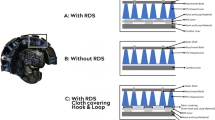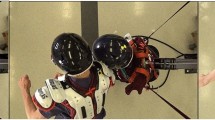Abstract
Concussive and subconcussive sports-related head impacts are common in the United States, particularly in American football. Football helmets are constantly improving upon their predecessors and are proven to reduce head impact kinematics and the risk of sports-related head injury. All football helmets are required to pass certification testing overseen by the National Operating Committee on Standards for Athletic Equipment (NOCSAE) before they are permitted for use. A new advance in protective equipment involves coupling a helmet and shoulder pads as one connected piece of protective equipment. These protective gears cannot be tested using the standard NOCSAE method as they are worn over a user’s head, neck, and upper torso. We aimed to test the effectiveness of a prototype of a coupled, one-piece design, relative to a standard football helmet, using a custom drop tower method of testing. Relative to the standard football helmet, the coupled design reduced measures of peak linear acceleration at front, side, and rear impacts (p < .001) and peak rotational acceleration at all tested head locations (p < .004). The coupled design was also more effective than the standard helmet in attenuating the resultant upper neck force (p < .004) at all tested head impact locations and resultant upper neck moment at rear and side impact locations (p < .048). Future iterations of coupled, one-piece designs should use the results of this study to make improvements to the device, and further investigations on the effectiveness and safety implications of the protective gear are necessary.





Similar content being viewed by others
References
Langlois JA, Rutland-Brown W, Wald MM (2006) The epidemiology and impact of traumatic brain injury: a brief overview. J Head Trauma Rehabil 21(5):375–378
Guskiewicz KM, Weaver NL, Padua DA, Garrett WE (2000) Epidemiology of concussion in collegiate and high school football players. Am J Sports Med 28(5):643–650
Kontos AP, Elbin RJ, Fazio-Sumrock VC, Burkhart S, Swindell H, Maroon J, Collins MW (2013) Incidence of sports-related concussion among youth football players aged 8–12 years. J Pediatr 163(3):717–720
Pellman EJ, Powell JW, Viano DC, Casson IR, Tucker AM, Feuer H, Lovell M, Waeckerle JF, Robertson DW (2004) Concussion in professional football: epidemiological features of game injuries and review of the literature—part 3. Neurosurgery 54(1):81–96
Bazarian JJ, Zhu T, Zhong J, Janigro D, Rozen E, Roberts A, Javien H, Merchant- Borna K, Abar B, Blackman EG (2014) Persistent, long-term cerebral white matter changes after sports-related repetitive head impacts. PLoS ONE 9(4):e94734
Montenigro PH, Alosco ML, Martin BM, Daneshvar DH, Mez J, Chaisson CE, Nowinski CJ, Au R, McKee AC, Cantu RC, McClean MD (2017) Cumulative head impact exposure predicts later-life depression, apathy, executive dysfunction, and cognitive impairment in former high school and college football players. J Neurotrauma 34(2):328–340
Talavage TM, Nauman EA, Breedlove EL, Yoruk U, Dye AE, Morigaki KE, Feuer H, Leverenz LJ (2014) Functionally-detected cognitive impairment in high school football players without clinically-diagnosed concussion. J Neurotrauma 31(4):327–338
Rowson S, Duma SM (2013) Brain injury prediction: assessing the combined probability of concussion using linear and rotational head acceleration. Ann Biomed Eng 41(5):873–882
Duhaime AC, Beckwith JG, Maerlender AC, McAllister TW, Crisco JJ, Duma SM, Brolinson PG, Rowson S, Flashman LA, Chu JJ, Greenwald RM (2012) Spectrum of acute clinical characteristics of diagnosed concussions in college athletes wearing instrumented helmets. J Neurosurg 117(6):1092–1099
Rowson S, Duma SM, Greenwald RM, Beckwith JG, Chu JJ, Guskiewicz KM, Mihalik JP, Crisco JJ, Wilcox BJ, McAllister TW, Maerlender AC (2014) Can helmet design reduce the risk of concussion in football? Technical note. J Neurosurg 120(4):919–922
National Operating Committee on Standards for Athletic Equipment (NOCSAE) (2017) Standard performance specification for newly manufactured football helmets. https://nocsae.org/wp-content/uploads/2018/05/1501096770ND00217m17aMfrdFBHelmetsStandardPerformance.pdf. Accessed 13 Mar 2018
Cantu RC, Mueller FO (2003) Catastrophic spine injuries in American football, 1977–2001. Neurosurgery 53(2):358–363
Levy ML, Ozgur BM, Berry C, Aryan HE, Apuzzo ML (2004) Analysis and evolution of head injury in football. Neurosurgery 55(3):649–655
Delaney JS, Al-Kashmiri A (2005) Neck injuries presenting to emergency departments in the United States from 1990 to 1999 for ice hockey, soccer, and American football. Br J Sports Med 39(4):e21
Viano DC, Halstead D (2012) Change in size and impact performance of football helmets from the 1970 s to 2010. Ann Biomed Eng 40(1):175–184
Viano DC, Pellman EJ, Withnall C, Shewchenko N (2006) Concussion in professional football: performance of newer helmets in reconstructed game impacts—part 13. Neurosurgery 59(3):591–606
Viano DC, Withnall C, Halstead D (2012) Impact performance of modern football helmets. Ann Biomed Eng 40(1):160–174
Broglio SP, Sosnoff JJ, Shin S, He X, Alcaraz C, Zimmerman J (2009) Head impacts during high school football: a biomechanical assessment. J Athl Train 44(4):342–349
Crisco JJ, Fiore R, Beckwith JG, Chu JJ, Brolinson PG, Duma S, McAllister TW, Duhaime AC, Greenwald RM (2010) Frequency and location of head impact exposures in individual collegiate football players. J Athl Train 45(6):549–559
Mihalik JP, Bell DR, Marshall SW, Guskiewicz KM (2007) Measurement of head impacts in collegiate football players: an investigation of positional and event-type differences. Neurosurgery 61(6):1229–1235
Namjoshi DR, Cheng WH, McInnes KA, Martens KM, Carr M, Wilkinson A, Fan J, Robert J, Hayat A, Cripton PA, Wellington CL (2014) Merging pathology with biomechanics using CHIMERA (Closed-head impact model of engineered rotational acceleration): a novel, surgery-free model of traumatic brain injury. Mol Neurodegener 9(1):55
Kawata K, Rubin LH, Takahagi M, Lee JH, Sim T, Szwanki V, Bellamy A, Tierney R, Langford D (2017) Subconcussive impact-dependent increase in plasma S100β levels in collegiate football players. J Neurotrauma 34(14):2254–2260
Pellman EJ, Viano DC, Tucker AM, Casson IR, Waeckerle JF (2003) Concussion in professional football: reconstruction of game impacts and injuries. Neurosurgery 53(4):799–814
Bishop PJ, Wells RP (1990) The inappropriateness of helmet drop tests in assessing neck protection in head-first impacts. Am J Sports Med 18(2):201–205
Rowson S, Duma SM (2011) Development of the STAR evaluation system for football helmets: integrating player head impact exposure and risk of concussion. Ann Biomed Eng 39(8):2130–2140
Rowson B, Terrell EJ, Rowson S (2018) Quantifying the effect of the facemask on helmet performance. Proc Inst Mech Eng P J Sports Eng Technol 232(2):94–101
Zanetti K, Post A, Marshall M, Karton C, Hoshizaki B, Gilchrist MD (2013) Identifying injury characteristics for three player positions in American football using physical and finite element modeling reconstructions. In: International research council on the biomechanics of injury (IRCOBI). Gothenburg, Sweden
Acknowledgments
NJC, TJO, and JJR have a financial interest in Popejoy Sports LLC. Funding for study expenses was provided by the Popejoy Family Trust.
Author information
Authors and Affiliations
Corresponding author
Additional information
Publisher's Note
Springer Nature remains neutral with regard to jurisdictional claims in published maps and institutional affiliations.
Rights and permissions
About this article
Cite this article
Cecchi, N.J., Oros, T.J., Ringhofer, J.J. et al. Comparison of head impact attenuation capabilities between a standard American football helmet and novel protective equipment that couples a helmet and shoulder pads. Sports Eng 22, 16 (2019). https://doi.org/10.1007/s12283-019-0311-8
Published:
DOI: https://doi.org/10.1007/s12283-019-0311-8




